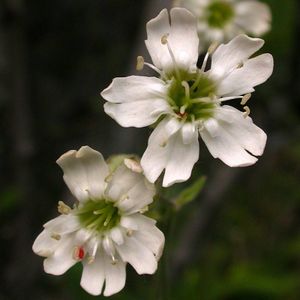Difference between revisions of "Silene douglasii"
(→Taxonomy) (Tag: VisualEditor) |
(Tag: VisualEditor) |
||
| Line 2: | Line 2: | ||
* Family: Caryophyllaceae | * Family: Caryophyllaceae | ||
* Common Names: Douglas's silene | * Common Names: Douglas's silene | ||
| + | * Synonyms/Misapplications: ''Silene douglasii'' var. ''monantha, Silene monantha, Silene multicaulis'' | ||
* Codon: SILDOU | * Codon: SILDOU | ||
[[File:SILDOU1.jpg|thumb|Photo Ben Legler 2004]] | [[File:SILDOU1.jpg|thumb|Photo Ben Legler 2004]] | ||
| Line 22: | Line 23: | ||
==Description== | ==Description== | ||
| − | + | Tufted perennial, basal leaves matted, long-petiolate, oblanceolate to linear-lanceolate, 2-5 cm. long and 2-7 mm. wide; cauline leaves 1-8 pairs, becoming smaller and sessile above. | |
| − | + | ||
Flowers: Flowers few, with linear bracts, often remote; calyx tubular, 5-lobed, 12-15 mm. long, becoming papery and enlarged in fruit; petals 5, creamy-white, greenish, pink or purplish; claw 8-12 mm long, the blade oblong, 4-6 mm. long, bi-lobed about ¼ the length; blade appendages 2, oblong, 1 mm. long; ovary stalk 3-4 mm. long; stamens 10; styles 3. | Flowers: Flowers few, with linear bracts, often remote; calyx tubular, 5-lobed, 12-15 mm. long, becoming papery and enlarged in fruit; petals 5, creamy-white, greenish, pink or purplish; claw 8-12 mm long, the blade oblong, 4-6 mm. long, bi-lobed about ¼ the length; blade appendages 2, oblong, 1 mm. long; ovary stalk 3-4 mm. long; stamens 10; styles 3. | ||
| Line 29: | Line 29: | ||
Fruits: Capsule 1-celled. | Fruits: Capsule 1-celled. | ||
| − | <ref>http://biology.burke.washington.edu/herbarium/imagecollection.php?Genus=Silene&Species=douglasii</ref> | + | <ref name=":0">WTU |
| + | Herbarium, Burke Museum, & University of Washington. Retrieved from http://biology.burke.washington.edu/herbarium/imagecollection.php?Genus=Silene&Species=douglasii</ref> | ||
==Bloom Period== | ==Bloom Period== | ||
Late May - July | Late May - July | ||
| − | <ref | + | <ref name=":0" /> |
==Distribution== | ==Distribution== | ||
| − | + | B.C. to California, in the Cacsades and Olympic Mountains, east to western Montana, Nevada and Utah.<ref name=":1">Hitchcock, C. L., Cronquist, A., Giblin, D., & Legler, | |
| − | <ref | + | B. et al. (2018). ''Flora of the Pacific Northwest: an illustrated manual''. |
| + | Seattle: University of Washington Press.</ref> | ||
==Habitat== | ==Habitat== | ||
Sagebrush plains to mountain slopes | Sagebrush plains to mountain slopes | ||
| − | <ref | + | <ref name=":1" /> |
==Uses== | ==Uses== | ||
Revision as of 18:44, 2 May 2020
- Scientific Name: Silene douglasii var. douglassii
- Family: Caryophyllaceae
- Common Names: Douglas's silene
- Synonyms/Misapplications: Silene douglasii var. monantha, Silene monantha, Silene multicaulis
- Codon: SILDOU
Contents
Taxonomy
| Silene douglasii | |
|---|---|
| Scientific classification | |
| Kingdom: | Plantae |
| Subkingdom: | Tracheobionta |
| Phylum: | Spermatophyta |
| Subphylum: | Magnoliophyta |
| Class: | Magnoliopsida |
| Subclass: | Caryophyllidae |
| Order: | Caryophyllales |
| Family: | Caryophyllaceae |
| Genus: | Silene L. |
| Species: | Silene douglasii Hook |
| Variety: | Silene douglasii var.douglasii |
Description
Tufted perennial, basal leaves matted, long-petiolate, oblanceolate to linear-lanceolate, 2-5 cm. long and 2-7 mm. wide; cauline leaves 1-8 pairs, becoming smaller and sessile above.
Flowers: Flowers few, with linear bracts, often remote; calyx tubular, 5-lobed, 12-15 mm. long, becoming papery and enlarged in fruit; petals 5, creamy-white, greenish, pink or purplish; claw 8-12 mm long, the blade oblong, 4-6 mm. long, bi-lobed about ¼ the length; blade appendages 2, oblong, 1 mm. long; ovary stalk 3-4 mm. long; stamens 10; styles 3.
Fruits: Capsule 1-celled.
Bloom Period
Late May - July [1]
Distribution
B.C. to California, in the Cacsades and Olympic Mountains, east to western Montana, Nevada and Utah.[2]
Habitat
Sagebrush plains to mountain slopes [2]
Uses
Nɨwɨ medicine, warm infusion of pounded plant used as an emetic for stomach pain.
Diné medicine, cold infusion used as lotion for coyote bite on man, sheep or horse. [3]
Propagation
Easily propagated by cutting or seed [4]
Photo Gallery
References
- ↑ 1.0 1.1 WTU Herbarium, Burke Museum, & University of Washington. Retrieved from http://biology.burke.washington.edu/herbarium/imagecollection.php?Genus=Silene&Species=douglasii
- ↑ 2.0 2.1 Hitchcock, C. L., Cronquist, A., Giblin, D., & Legler, B. et al. (2018). Flora of the Pacific Northwest: an illustrated manual. Seattle: University of Washington Press.
- ↑ Native American Ethnobotany Database. Retrieved from http://herb.umd.umich.edu/herb/search.pl?searchstring=Silene%20douglasii
- ↑ http://www.wildflower.org/plants/result.php?id_plant=SIDO




